Several species of freshwater crabs and shrimps are recorded from Singapore, with the native species being found mostly in clear forest streams, and the introduced species in reservoirs and ponds.
Crabs and shrimps are of the order Decapoda, and like other members of this order, they have five pairs of "legs", including the clawed arms ("deca" means "ten", while "poda" means "feet"). They also have leaf-like gills, a distinctive characteristic of decapods from the suborder Pleocyemata. And as with other crustaceans from the class Malacostraca, their body comprises three main parts - a head with five segments, a thorax with eight segments, and an abdomen with six segments. The head is fused with the thorax to form a cephalothorax. They have a tough exoskeleton strengthened with calcium carbonate, and the carapace covers the gills but not the abdomen.
Crabs (infraorder Brachyura) can be distinguished from other similar-looking decapods by having a broad carapace, a very short and flattened abdomen which is usually folded underneath the body, a pair of clawed arms, and four pairs of walking legs. Sometimes, one or more pairs of legs may be modified for swimming or other purposes. Their antennae are relatively short, and their eyes are on stalks.
The shrimps found in our freshwater environments are caridean shrimps (infraorder Caridea). They have an elongate abdomen bearing five pairs of swimming appendages (or pleopods) and ending off with a tail fan. The tail fan comprises a pointed, tail-like structure (or telson) in the middle and a pair of flattened appendages (or uropods) by the sides. The pleopods are used for brooding the eggs and for swimming, while the uropods are used for steering while swimming. They can be distinguished from the similar-looking prawns (suborder Dendrobranchiata) by the lack of pincers at the tips of their third pair of walking legs. Also, the "shell" of the second abdominal segment is enlarged, overlapping and covering part of the first segment and the third segment. Internally, caridean shrimps have gills that are leaf-like, while prawns have gills that are branch-like.
Crabs and shrimps reproduce sexually, and have separate sexes. Unlike penaeid prawns that release their eggs into the water, they brood their eggs under their abdomen until they hatch.
Here are some of the freshwater crabs and shrimps that I have photographed in Singapore. The marine crabs and shrimps will be treated in separate entries.
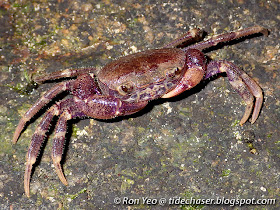
The Singapore Freshwater Crab (Johora singaporensis) is one of the rarest animals in the world, and was in fact listed recently as the top 100 most threatened species in the world during the International Union for the Conservation of Nature's World Conservation Congress. Its colour varies from a dirty brown to purplish brown, with the big ones being more purplish. It can be distinguished from other native brownish freshwater crabs by the fine and stiff hair covering its carapace and legs. The carapace usually does not get more than 3cm wide. This species was previously confused with other crab species, and was only discovered to be a separate species in 1986! It is endemic to Singapore (i.e. not found any where else in the world).

The above is a smaller specimen that is more uniformly brownish in colour. The carapace of the Singapore Freshwater Crab is somewhat trapezoidal with rounded corners. This species usually occurs in clear, clean water, oxygen-rich and fast-flowing forest streams, usually at higher elevations.

Bigger specimens tend to have pale bands on the legs, purplish-red pincers, and a generally more purplish overall coloration. Singapore Freshwater Crabs feed on plant materials and small invertebrates. They are usually found under the leaf litter or rocks.

The Johnson's Freshwater Crab (Irmengardia johnsoni) can sometimes be confused with the previous species due to its brownish coloration, but it lacks the numerous fine hairs covering the body of the latter. This species is endemic to Singapore (i.e. not found any where else in the world), and was only identified as a new species in 1985.

The carapace can get to about 3cm wide, and is often marked with dark brown botches or speckles.
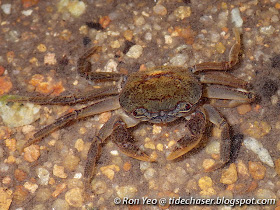
It is usually found at slower parts of shaded streams, and sometimes, at the edges of reservoirs. Its diet comprises dead leaves and freshwater invertebrates.

The Maculate Freshwater Crab (Parathelphusa maculata) or Lowland Freshwater Crab is usually found in lowland streams. It appears to be able to tolerate low oxygen conditions, and hence is found in stagnant pools sometimes. This species is known to dig deep burrows up to 1m deep at the banks of the stream. The burrow opening is usually above the water level, but the lower part is usually filled with water.
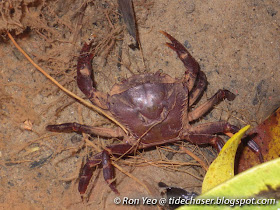
The colour varies from light brown with spots and speckles to dark brown. They are known to feed on both plant materials and small animals.

It can be distinguished from the previous two species by the two sharp spines at the two front corners of the carapace. Apart from the Maculate Freshwater Crab, another Parathelphusa species, P. reticulata, can also be found in Singapore. This species is not featured here as I still do not have photos of it. It is endemic to Singapore, and has dark, honeycomb patterns on its back.
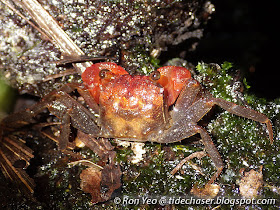
Two Geosesarma species occur in Singapore, and the above is a Little Land Crab (Geosesarma nemesis). It can be distinguished from the other species (G. perracae that is not featured here) by its squarish carapace (the latter has a trapezoidal carapace). The maximum carapace width is about 1.5cm. The color ranges from bright red to brownish. It is mostly a scavenger.

The Little Land Crab is mostly terrestrial, and is known to burrow under rocks near the stream. This species prefer highlands, unlike the other local land crab which prefers lowland areas. The above features a female with smaller claws.

The male Little Land Crab has a pair of larger chelipeds. It can be distinguished from G. perracae by the lacking of a wide gap between the fingers of the pincers.

Several species of freshwater shrimps occur in Singapore, and the most easily seen ones are the Macrobrachium shrimps (Macrobrachium spp.) They usually have a pair of much enlarged claws. The above photo features an unidentified species. The above Macrobrachium shrimp is found in a clear, fast-flowing, hill-side forest stream. It si about 5cm long.
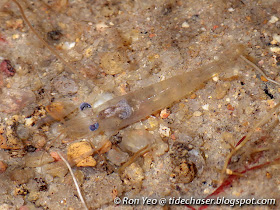
Macrobrachium shrimps are usually hard to identify unless they are caught and examine carefully. And hence I will not attempt to identify them here. The above is another example of a Macrobrachium shrimp. It is found in a clear, fast flowing, hill-side forest stream. It is about 5cm long.

The above Macrobrachium species is found on a wide and slower-flowing, lowland forest stream. It is about 4cm long.

The Oriental River Prawn (Macrobrachium nipponense) has been introduced into some of our reservoirs, and the mature ones can be recognised by the long and large claws. It is native to East Asia, and grows to about 8cm long (excluding the claws).
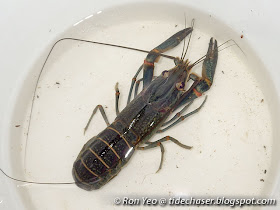
The Redclaw Crayfish (Cherax quadricarinatus) is possibly introduced by irresponsible pet owners into several of our reservoirs and ponds. It is easily recognised by its bluish coloration. This species is native to Australia, and can grow to about 25cm long (excluding the claws)
References
Crabs and shrimps are of the order Decapoda, and like other members of this order, they have five pairs of "legs", including the clawed arms ("deca" means "ten", while "poda" means "feet"). They also have leaf-like gills, a distinctive characteristic of decapods from the suborder Pleocyemata. And as with other crustaceans from the class Malacostraca, their body comprises three main parts - a head with five segments, a thorax with eight segments, and an abdomen with six segments. The head is fused with the thorax to form a cephalothorax. They have a tough exoskeleton strengthened with calcium carbonate, and the carapace covers the gills but not the abdomen.
Crabs (infraorder Brachyura) can be distinguished from other similar-looking decapods by having a broad carapace, a very short and flattened abdomen which is usually folded underneath the body, a pair of clawed arms, and four pairs of walking legs. Sometimes, one or more pairs of legs may be modified for swimming or other purposes. Their antennae are relatively short, and their eyes are on stalks.
The shrimps found in our freshwater environments are caridean shrimps (infraorder Caridea). They have an elongate abdomen bearing five pairs of swimming appendages (or pleopods) and ending off with a tail fan. The tail fan comprises a pointed, tail-like structure (or telson) in the middle and a pair of flattened appendages (or uropods) by the sides. The pleopods are used for brooding the eggs and for swimming, while the uropods are used for steering while swimming. They can be distinguished from the similar-looking prawns (suborder Dendrobranchiata) by the lack of pincers at the tips of their third pair of walking legs. Also, the "shell" of the second abdominal segment is enlarged, overlapping and covering part of the first segment and the third segment. Internally, caridean shrimps have gills that are leaf-like, while prawns have gills that are branch-like.
Crabs and shrimps reproduce sexually, and have separate sexes. Unlike penaeid prawns that release their eggs into the water, they brood their eggs under their abdomen until they hatch.
Here are some of the freshwater crabs and shrimps that I have photographed in Singapore. The marine crabs and shrimps will be treated in separate entries.

The Singapore Freshwater Crab (Johora singaporensis) is one of the rarest animals in the world, and was in fact listed recently as the top 100 most threatened species in the world during the International Union for the Conservation of Nature's World Conservation Congress. Its colour varies from a dirty brown to purplish brown, with the big ones being more purplish. It can be distinguished from other native brownish freshwater crabs by the fine and stiff hair covering its carapace and legs. The carapace usually does not get more than 3cm wide. This species was previously confused with other crab species, and was only discovered to be a separate species in 1986! It is endemic to Singapore (i.e. not found any where else in the world).

The above is a smaller specimen that is more uniformly brownish in colour. The carapace of the Singapore Freshwater Crab is somewhat trapezoidal with rounded corners. This species usually occurs in clear, clean water, oxygen-rich and fast-flowing forest streams, usually at higher elevations.

Bigger specimens tend to have pale bands on the legs, purplish-red pincers, and a generally more purplish overall coloration. Singapore Freshwater Crabs feed on plant materials and small invertebrates. They are usually found under the leaf litter or rocks.

The Johnson's Freshwater Crab (Irmengardia johnsoni) can sometimes be confused with the previous species due to its brownish coloration, but it lacks the numerous fine hairs covering the body of the latter. This species is endemic to Singapore (i.e. not found any where else in the world), and was only identified as a new species in 1985.

The carapace can get to about 3cm wide, and is often marked with dark brown botches or speckles.

It is usually found at slower parts of shaded streams, and sometimes, at the edges of reservoirs. Its diet comprises dead leaves and freshwater invertebrates.

The Maculate Freshwater Crab (Parathelphusa maculata) or Lowland Freshwater Crab is usually found in lowland streams. It appears to be able to tolerate low oxygen conditions, and hence is found in stagnant pools sometimes. This species is known to dig deep burrows up to 1m deep at the banks of the stream. The burrow opening is usually above the water level, but the lower part is usually filled with water.

The colour varies from light brown with spots and speckles to dark brown. They are known to feed on both plant materials and small animals.

It can be distinguished from the previous two species by the two sharp spines at the two front corners of the carapace. Apart from the Maculate Freshwater Crab, another Parathelphusa species, P. reticulata, can also be found in Singapore. This species is not featured here as I still do not have photos of it. It is endemic to Singapore, and has dark, honeycomb patterns on its back.

Two Geosesarma species occur in Singapore, and the above is a Little Land Crab (Geosesarma nemesis). It can be distinguished from the other species (G. perracae that is not featured here) by its squarish carapace (the latter has a trapezoidal carapace). The maximum carapace width is about 1.5cm. The color ranges from bright red to brownish. It is mostly a scavenger.

The Little Land Crab is mostly terrestrial, and is known to burrow under rocks near the stream. This species prefer highlands, unlike the other local land crab which prefers lowland areas. The above features a female with smaller claws.

The male Little Land Crab has a pair of larger chelipeds. It can be distinguished from G. perracae by the lacking of a wide gap between the fingers of the pincers.

Several species of freshwater shrimps occur in Singapore, and the most easily seen ones are the Macrobrachium shrimps (Macrobrachium spp.) They usually have a pair of much enlarged claws. The above photo features an unidentified species. The above Macrobrachium shrimp is found in a clear, fast-flowing, hill-side forest stream. It si about 5cm long.

Macrobrachium shrimps are usually hard to identify unless they are caught and examine carefully. And hence I will not attempt to identify them here. The above is another example of a Macrobrachium shrimp. It is found in a clear, fast flowing, hill-side forest stream. It is about 5cm long.

The above Macrobrachium species is found on a wide and slower-flowing, lowland forest stream. It is about 4cm long.

The Oriental River Prawn (Macrobrachium nipponense) has been introduced into some of our reservoirs, and the mature ones can be recognised by the long and large claws. It is native to East Asia, and grows to about 8cm long (excluding the claws).

The Redclaw Crayfish (Cherax quadricarinatus) is possibly introduced by irresponsible pet owners into several of our reservoirs and ponds. It is easily recognised by its bluish coloration. This species is native to Australia, and can grow to about 25cm long (excluding the claws)
References
- De Grave, S., N. D. Pentcheff , S. T. Ahyong, T.-Y. Chan, K. A. Crandall, P. C. Dworschak, D. L. Felder, R. M. Feldmann, C. H. J. M. Fransen, L. Y. D. Goulding, R. Lemaitre, M. E. Y. Low, J. W. Martin, P. K. L. Ng, C. E. Schweitzer, S. H. Tan, D. Tshudy & R. Wetzer. 2009. A classification of living and fossil genera of decapod crustaceans. The Raffles Bulletin of Zoology, supplement 21, pp. 1-109.
- Debelius, H. 1999. Crustacea - Guide of the world. IKAN, Frankfurt. 321pp.
- Ng, P. K. L. 1988. The freshwater crabs of Peninsular Malaysia and Singapore. Shinglee Press. Singapore. vii + 156. pp. 4. color pls.
- Ng, P. K .L., R. T. Corlett & H.T.W. Tan (eds.). 2011. Singapore biodiversity: An encyclopedia of the natural environment and sustainable development. Singapore: Editions Didier Millet. 552 pp.
- Yeo, D C. J. 2010. Introduced decapod crustaceans in Singapore's reservoirs, Cosmos 6(1): 83-88
- Yeo, D. C. J., L. K. Wang & K. K. P. Lim (eds..) 2010. Private lives: An exposé of Singapore's freshwaters. Raffles Museum of Biodiversity Research, Department of Biological Sciences, National University of Singapore. 258 pp.

No comments:
Post a Comment